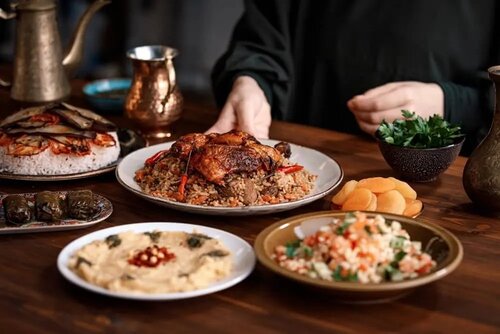

The United Arab Emirates (UAE) is a country at the nexus of modernity and tradition. The country's rich cultural heritage is deeply rooted in its multicultural society. One of the most vibrant representations of this cultural heritage is found in Emirati cuisine. Let's explore traditional food in the UAE to learn about the flavours that distinguish this lively region.
Emirati food reflects the nation's history, topography, and Bedouin heritage. The use of flavourful spices, fresh ingredients, and a methodical cooking technique handed down through generations define traditional food in the UAE.
Dubai, the crown jewel of the UAE, has a diverse culinary scene that reflects the various cultures in the city. Here are a few of the top dishes commonly served in the Emirate that illustrate traditional food in the UAE:
In Dubai, Harees is among the most well-known foods. It is frequently present on Emirati dinner tables and on the menus of some of the best restaurants in Dubai. Due to the time and skill required in its creation, it is frequently served at banquets, weddings, and special occasions.
Harees is a traditional Emirati food made from crushed wheat, minced beef or chicken, onions, ground cumin, salt, and water. It is a significant part of the regional culinary heritage and is still popular. Recipes for Harees have been passed down through generations.
Known as one of the most popular dishes in traditional food in the UAE, Majboos is a traditional rice dish from Dubai. It is typically prepared with meat, usually chicken or lamb, and seasoned with cinnamon and cardamom. The rice is cooked using leftover water from the meat, which infuses the rice with incredible flavour. Majboos is a staple dish during iftar meals and is passed down through generations of families.
One of Dubai's most loved dishes is Madhrooba, which is also popular in Bahrain and Oman. The most popular type of Madhrooba is eaten with chicken, but it can also be had with fish, lamb, or crushed grains. Garlic, onion, rice, tomatoes, yoghurt, and seasoning are used in its preparation. The recipe's final step involves beating the ingredients together to create a smooth mash, hence the term "madhrooba," which translates to "beaten" in Arabic.
Biryani is a popular meal in the Gulf region, including Dubai. Its origin lies in Indian cuisine, and it has gained immense popularity across East Asia and the Arab world due to its delicious and savoury flavour. The dish is made using Indian spices known for their potent flavours and scents.
There are numerous types of biryani, including Southeast Asian, Sri Lankan, Iranian, and Katchi. Meat biryani, made with basmati rice and spices, goes well with chicken or other meats.
Despite the influx of Western cuisine into Emirates restaurants, Saloona has retained its popularity among the people of the United Arab Emirates, and it continues to grace many dinner tables. This Emirati stew is renowned for its simple preparation, mouth-watering flavour, and captivating aroma, making it a must-try dish in Dubai.
This dish is a standard part of feasts and celebrations in the Emirates. It uses white rice, turmeric, olive oil, ginger, garlic, onion, chilli, and spices. This meal is packed with protein and vitamins and is beloved by locals and visitors alike.
Khuzi is the national dish of the UAE. It is a dish of roast lamb presented with nuts, veggies, and raisins on top of a bed of spicy rice. The spices produce a rich flavour, usually cardamom, cinnamon, saffron, and nutmeg. Even though it's traditionally served at special events, many restaurants offer it all year round.
A well-known addition to Dubai's traditional food is Luqaymat, which is produced for various cultural events conducted around the Emirates. They are regarded as a "must-have'' dessert for restaurants and homes, particularly on special occasions.
These small, sweet pastries have a round shape and are very soft. To make them, you need sesame seeds, flour, milk, sugar, salt, and yeast. After kneading the batter, fry it in oil, cover it with syrup, and let it rest. Some people think these pastries come from the Arab world, specifically from 'Awama or halwa al-luqaymat. However, the Greeks also had a similar pastry called loukoumades. The syrup (sharbat), which looks like honey and is used to top the pastries, comes from Turkey.
You'll find a great mix of traditional and modern dining options when you visit Ibn Battuta Mall. Exploring the mall is not just limited to shopping; it is also about discovering the different flavours of the ever-changing Emirati culinary scene. The mall is a unique example of Dubai's fusion of Emirati culture, innovation, and heritage. Every corner of this bustling city offers a taste of history and traditions.
Share this article Share
Share this article Share
